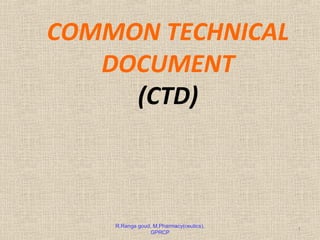
Ctd
- 1. COMMON TECHNICAL DOCUMENT (CTD) R.Ranga goud, M.Pharmacy(ceutics), 1 GPRCP
- 2. CONTENTS: Introduction ORGANISATION OF CTD • 1) Module-1 • 2)Module-2 • 3)Module-3 • 4)Module-4 • 5)Module-5 CONCLUSION REFERENCES R.Ranga goud, M.Pharmacy(ceutics), 2 GPRCP
- 3. INTRODUCTION: CTD was agreed in November 2000 in San Diego,USA. It provides for a harmonized structure and format for new product applications. CTD is a set of specification for application dossier for the registration of medicines and designed to be used across Europe, Japan &US. CTD was developed by the European medicines agency(EMEA),Food&Drug Administration(FDA),the ministry of health,labour&wRe.Ralnfgaa rgoeud(, JMa.Ppharamancy)(c.eutics), 3 GPRCP
- 4. CTD is maintained by the ICH (International Conference on Harmonization) of technical requirement for registration of pharmaceuticals for human use. The FDA characterized the CTD as “An information package of clinical ,non-clinical, manufacturing, technical data in the same format and with the same content, that would be submitted for registering new drugs in all three ICH regions i.e.; US, European Union and Japan. R.Ranga goud, M.Pharmacy(ceutics), 4 GPRCP
- 5. ORGANISATION OF CTD: It should be organized into 5 modules. Module-1Administrative&prescribing information. Module-2Overview&summery of modules 3-5. Module-3Quality(pharmaceutical documentation). Module-4Safety toxicology studies. Module-5Efficacy clinical studies. Module-1 is region specific. Module-2,3,4&5 are intended to be common for all regions. 5 R.Ranga goud, M.Pharmacy(ceutics), GPRCP
- 6. 1.0Régional Administrative Information 2.1 ToC of the CTD (Mod 2,3,4,5) 2.2 Introduction 2.3Quality Overall Summary 2.4Nonclinical Overview 2.5Clinical Overview 2.6Nonclinical Written and Tabulated Summaries 2.7Clinical Summary Module 1 1.0 2.1 2.2 2.3 2.4 2.5 2.6 2.7 Module 3 Module 4 Module 5 Quality Nonclinical Study Reports Clinical Study Reports Module 2 6 R.Ranga goud, M.Pharmacy(ceutics), GPRCP
- 7. MODULE-1: • This module should contain documents specific to each region. • Ex: Application forms regarding the prescribing information, proposed label. • This module is not part of the CTD. • The content & format of this module can be specified by the relevant regulatory authorities. R.Ranga goud, M.Pharmacy(ceutics), 7 GPRCP
- 8. MODULE-2: • It should begin with a general introduction to the pharmaceutical, including it’s pharmacological class, mode of action& proposed clinical use. In general, the information should not exceed one page. • Module-2 should contain 7 sections in the fallowing order: 1) CTD table of contents. 2) CTD introduction. 3) Quality& overall summery. 4) Non-clinical overview. 5) Clinical overview. 6) Non-clinical written& tabulated summaries. 7) Clinical summary. R.Ranga goud, M.Pharmacy(ceutics), 8 GPRCP
- 9. • The individual organization of these summaries is described in three separate documents. a) M4 Q The CTD Quality. b) M4S The CTD Safety. c) M4 E The CTD Efficacy. a)M4 Q: The Quality section of the CTD provides a harmonized structure and format for presenting CMC (Chemistry, Manufacturing, Controls) information in a registration dossier. The table of contents include sections on Drug substances & Drug products. R.Ranga goud, M.Pharmacy(ceutics), 9 GPRCP
- 10. • Due to the fact that many CMC topics have not yet been the subject of ICH guidelines (Ex: Drug product manufacture, Drug substance synthesis), the content of CTD-Q is not totally harmonized. b) M4-S: CTD for the Registration of pharmaceuticals for human use Safety. Module-2 Non-clinical overview & Non-clinical summary. Module-4 Non-clinical study reports. R.Ranga goud, M.Pharmacy(ceutics), 10 GPRCP
- 11. • M4 S describes the structure and format of the non-clinical data in module-2 of the CTD. • It also provide the organisation of module-4 i.e.; the non-clinical study reports. • Non-clinical overview should present an integrated and critical assessment of the pharmacological, pharmacokinetic & toxicological evaluation of the pharmaceuticals.(should not exceed 30 pages) • The non-clinical written summaries (100-150 pages) are to provide more extensive summaries and discussion of non-clinical information on pharmacology, pharmacokinetics & toxicology. R.Ranga goud, M.Pharmacy(ceutics), 11 GPRCP
- 12. c) M4-E: The CTD For the Registration of pharmaceuticals for human use . Module -2 Clinical overview & clinical summery. Module-5 clinical study reports. M4 E describes the structure and format of the clinical data in an application, including summaries and detailed study reports. There are two high level clinical summaries in module-2 of the CTD: 12 R.Ranga goud, M.Pharmacy(ceutics), GPRCP
- 13. 1. Clinical overview: A short document that provides a critical assessment of the clinical data. 2. Clinical summary: A longer document that focuses on data summarization and integration. 13 R.Ranga goud, M.Pharmacy(ceutics), GPRCP
- 14. MODULE-3:(Quality) • Information on Quality should be presented in the structured format . • This is described in the guidance M4-Q. • Literature References 14 R.Ranga goud, M.Pharmacy(ceutics), GPRCP
- 15. MODULE-4: • In this explains the non-clinical study reports. • The non-clinical study reports should be presented in the order described in the guidance M4- S. • Literature References. 15 R.Ranga goud, M.Pharmacy(ceutics), GPRCP
- 16. MODULE-5: • In this explains the clinical study reports. • The human study reports and related information should be presented in the order described in the guidance M4- E. • Literature References. 16 R.Ranga goud, M.Pharmacy(ceutics), GPRCP
- 17. CONCLUSION • There is now a common format for the submission of Marketing Authorizations Applications across the three ICH regions - Europe, Japan and the USA. This should facilitate pharmaceutical companies to make simultaneous filings in the ICH regions as it will eliminate the extensive work previously required to convert, for example, a US dossier to an EU dossier and vice versa. R.Ranga goud, M.Pharmacy(ceutics), 17 GPRCP
- 18. REFERENCES www.wikipedia.com www.wipo.org 18 R.Ranga goud, M.Pharmacy(ceutics), GPRCP
- 19. 19 R.Ranga goud, M.Pharmacy(ceutics), GPRCP
